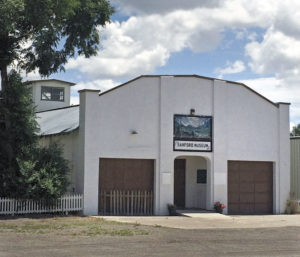By Mary Pope-Cornum
Sitting in the middle of the main street of Sanford, Colorado is a white-washed, Spanish-style adobe building. A hand-painted sign above the door declares this the Sanford Museum. The sign was arranged for by one of the museum’s originators, Gary Bailey, and painted by a missionary who was in the area at the time. The museum was initiated by Sanford native Mary June Peterson Miller, who wrote a historical book about Sanford titled We Call it Home. She passed away in 2015.
The building, which houses the museum is a museum in-and-of itself as part of the area’s history. It was built in 1937 as a government project through the Works Progress Administration (WPA). Since that time it has housed a community center, firehouse, town hall, church meetings and band practice rooms for local students. An aerial lookout tower was built around 1955.
[InContentAdTwo]
The decision to convert the building to a museum was made in 1995. The building has four rooms including a Pike’s Stockade room, with a mock-up of Zebulon Pike’s stockade and information regarding it. In other rooms, military uniforms hang along walls, with pictures and tributes to those who wore them. A plat of the town shows all the properties and their residents and visitors like to look for relatives’ houses on it.
Artifacts such as dresses, dolls and pictures were contributed by many families to commemorate their ancestors. Displays include an old cast iron stove, irons, dishes, appliances, and pictures of days gone by. Most of the history on display starts in the years after Sanford was settled in the late 1880s, with only a little of the earliest history of the town, which was settled by early Mormons migrating from Utah and the southern states, including a band of Catawba Indians who were part of the early Mormon settlers. Descendants of the Catawba still live in the area.
 A log cabin located by the museum is thought to be one of the oldest homes in Sanford. It was moved from the center of town to its present location. At one point a midwife lived in the cabin and women would go there for their “laying in” and deliver their children. My own father-in-law, Duwayne Cornum was born there in 1915.
A log cabin located by the museum is thought to be one of the oldest homes in Sanford. It was moved from the center of town to its present location. At one point a midwife lived in the cabin and women would go there for their “laying in” and deliver their children. My own father-in-law, Duwayne Cornum was born there in 1915.
Early Mormon settlers originally stopped in Ephriam, southeast of Sanford. Ephriam, as a settlement, no longer exists since the residents moved to what is now Sanford. The town was originally named Alma, after one of the early settlers, Thomas Alma Crowther. It was later discovered that Colorado already had a town named Alma, so the name was changed to Sanford, after another early settler, Silas Sanford Smith. Both are buried in the Sanford Pioneer Cemetery southwest of town.
The museum committee is always looking for stories and historical mementos to help bring those earliest times to life for future generations.
The museum is generally open by appointment only. There are special days that the museum is open to the public and those are posted. More about the museum can be found at www.colorado.com/history-museums/sanford-museum.
The Sanford Museum, 778 Main St, Sanford, CO 91151. 719-274-4382.
The Lookout Tower
One of the more memorable events happening around this building was the implementation of the Civil Defense Project. Many towns across the nation were asked to erect lookout towers to “spot” for enemy aircraft. Circa 1955 Sanford was asked to do this, and a schedule was set up for an adult along with a Boy Scout to man the tower. We were in the middle of the Cold War at that time and if memory serves, our boys were on the lookout for Russian aircraft.
While many of the details have been lost, even with the senior crowd that participated, some remain intact. A telephone, and a manual depicting the shapes of planes, was set up in the Sanford lookout tower. If a plane was spotted, its shape was called in to an entity now forgotten. Some planes were spotted and called in but to anyone’s knowledge an enemy aircraft was never identified.
This is a story dear to my family since my father-in-law, Duwayne Cornum, was mayor at the time, oversaw the building of the tower and the program. My husband Hal remembers when he was nine or ten following his brother Tennis who was fifteen or sixteen into the tower for his turn at watch. They were second and third eyes for Phil Reynolds that night.
One night on another of these expeditions into the tower, Hal’s granddad spent a shift with three others including Hal. Seemed to be a buddy thing too. The tower is very small, so I have no idea how all of that worked out.


